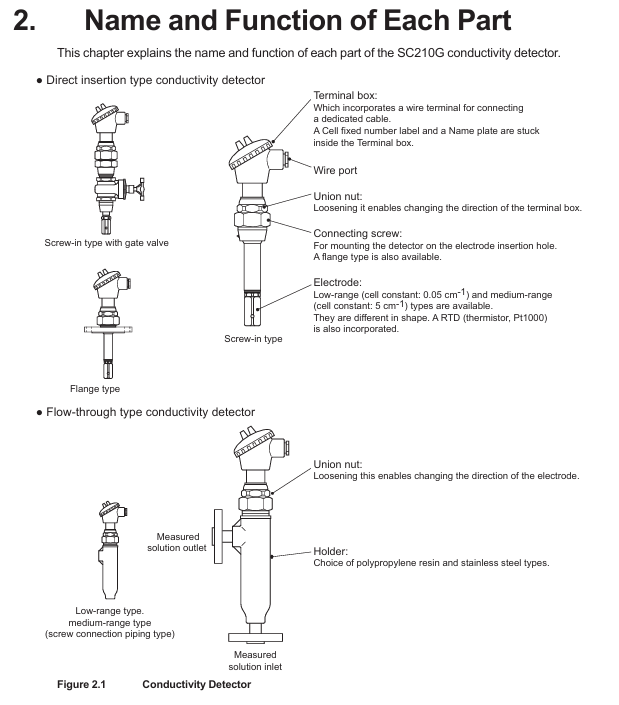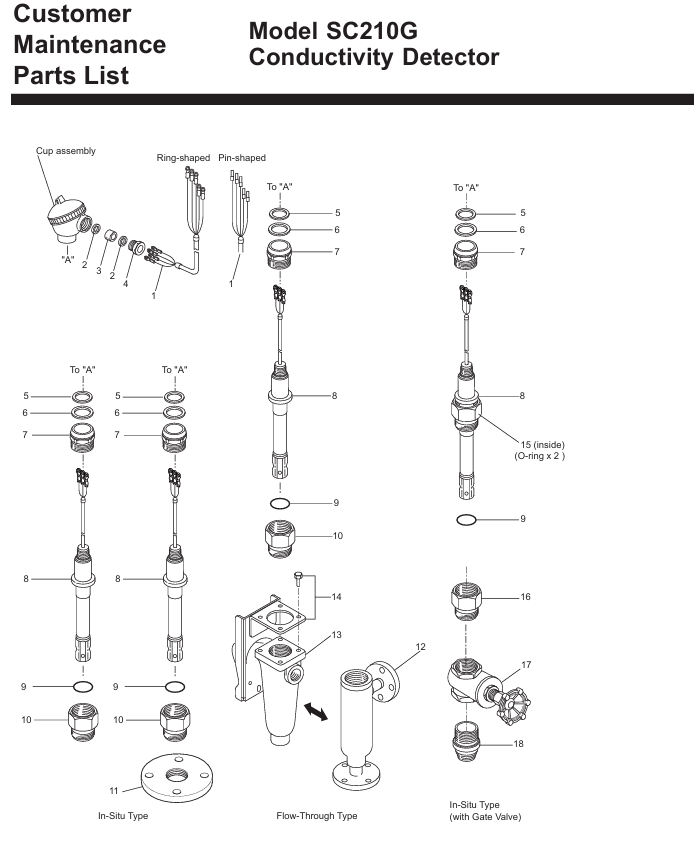YOKOGAWA SC210G Conductivity Detector
Corresponding manual number for supporting equipment type
FLXA202, FLXA21 2-wire liquid analyzer IM 12A01A02-01E
FLXA402 4-wire converter IM 12A01F01-02EN, IM 12A01F03-01EN, etc
FLXA402T turbidity and chlorine liquid analyzer IM 12A01G01-02EN, IM 12A01G03-01EN, etc
SC450G 4-wire conductivity converter IM 12D08N05-01E
Wiring: The cable length is provided according to the order (3/5/10/15/20m), and the terminals are divided into M4 ring type (compatible with FLXA202/FLXA21), M3 ring type (compatible with FLXA402/FLXA402T/SC450G), and pin type (compatible with multiple devices); The cable should avoid contact with high-temperature components, and the joint locking nut should be tightened for waterproofing after connection. The insulation resistance between the core wires should be ≥ 2 M Ω

Operation and maintenance process
1. Preparation before operation and steady-state operation
Inspection items: correctness of wiring, compatibility of piping materials, solution level (flow type needs to go to the outlet), no leakage; After startup, it is necessary to confirm that there is no bubble interference and no sudden temperature changes (to avoid affecting measurement accuracy)
Steady state maintenance: Conventional solutions (free of pollutants) can be maintained for 1 year without maintenance; Regular calibration with standard solution is required to ensure accuracy; If the analyzer outputs a FAIL signal, refer to the analyzer manual for troubleshooting
2. Core maintenance operations
(1) Electrode cleaning
Cleaning cycle: Low range (0.05 cm ⁻¹) electrodes require almost no cleaning due to minimal impurities in the solution; Medium range (5 cm ⁻¹) electrodes should be cleaned as needed (if the analyzer indicates abnormal electrode polarization)
Cleaning method: Type C (clean the inner and outer electrodes, only the inside of the hole needs to be cleaned externally); D-type (glass material requires a protective tube, gently wipe the platinum electrode on the inner wall of the glass tube with a thin rod wrapped in degreasing cotton)
(2) O-ring replacement
Replacement timing: O-ring damage can cause leakage, and regular inspections are required in high-temperature solution scenarios; Conventional O-ring (fluororubber, model K9050AT/K9050MR), with gate valve model requiring replacement with dedicated O-ring (K9050MS)
Replacement steps: For non gate valve types, simply loosen the union nut and remove the electrode to replace it; The gate valve type needs to first remove the external electrode and locking nut, remove the stop screw and replace the O-ring (recommended to replace in pairs), and calibrate the battery constant after reinstallation
(3) Electrode component replacement
Replacement condition: When the electrode is judged to be faulty (if there is still a large deviation after calibration)
Step: Power off → Remove the connection between the junction box and the electrode (use an Allen wrench to unscrew the electrode assembly) → Install a new component and wire it according to the color (green → C1, yellow → C2, red/black → T1/T2) → Update the battery constant label in the junction box → Enter the new battery constant in the analyzer

- EMERSON
- Honeywell
- CTI
- Rolls-Royce
- General Electric
- Woodward
- Yaskawa
- xYCOM
- Motorola
- Siemens
- Rockwell
- ABB
- B&R
- HIMA
- Construction site
- electricity
- Automobile market
- PLC
- DCS
- Motor drivers
- VSD
- Implications
- cement
- CO2
- CEM
- methane
- Artificial intelligence
- Titanic
- Solar energy
- Hydrogen fuel cell
- Hydrogen and fuel cells
- Hydrogen and oxygen fuel cells
- tyre
- Chemical fiber
- dynamo
- corpuscle
- Pulp and paper
- printing
- fossil
- FANUC
- Food and beverage
- Life science
- Sewage treatment
- Personal care
- electricity
- boats
- infrastructure
- Automobile industry
- metallurgy
- Nuclear power generation
- Geothermal power generation
- Water and wastewater
- Infrastructure construction
- Mine hazard
- steel
- papermaking
- Natural gas industry
- Infrastructure construction
- Power and energy
- Rubber and plastic
- Renewable energy
- pharmacy
- mining
- Plastic industry
- Schneider
- Kongsberg
- NI
- Wind energy
- International petroleum
- International new energy network
- gas
- WATLOW
- ProSoft
- SEW
- wind
- ADVANCED
- Reliance
- YOKOGAWA
- TRICONEX
- FOXBORO
- METSO
- MAN
- Advantest
- ADVANCED
- ALSTOM
- Control Wave
- AB
- AMAT
- STUDER
- KONGSBERG
- MOTOROLA
- DANAHER MOTION
- Bently
- Galil
- EATON
- MOLEX
- Triconex
- DEIF
- B&W
- ZYGO
- Aerotech
- DANFOSS
- KOLLMORGEN
- Beijer
- Endress+Hauser
- MOOG
- KB
- Moxa
- Rexroth


Email:wang@kongjiangauto.com






















































































































